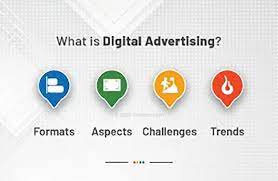The Power of Digital Media Advertising
Digital media advertising has revolutionised the way businesses connect with their target audiences. In today’s fast-paced world, where almost everyone is constantly connected to the internet, digital advertising offers a powerful platform to reach and engage potential customers.
One of the key advantages of digital media advertising is its ability to target specific demographics with precision. Through data analytics and advanced targeting tools, advertisers can tailor their messages to reach the right audience at the right time. This not only maximises the impact of advertising campaigns but also helps in driving better results and return on investment.
Furthermore, digital media advertising provides real-time feedback and insights that traditional advertising channels lack. Advertisers can track performance metrics such as click-through rates, conversion rates, and engagement levels instantly. This data-driven approach allows for quick adjustments and optimizations, ensuring that campaigns are always on track to meet their objectives.
Another significant benefit of digital media advertising is its scalability and flexibility. Whether you’re a small local business or a global corporation, digital platforms offer a range of options to suit your budget and goals. From social media ads to search engine marketing, there are diverse channels available to help you reach your target audience effectively.
In conclusion, digital media advertising has become an indispensable tool for businesses looking to stay competitive in today’s digital landscape. By harnessing the power of data-driven insights, precise targeting capabilities, real-time feedback, and scalability, advertisers can create impactful campaigns that resonate with their audience and drive business growth.
Understanding Digital Media Advertising: Key Questions and Insights for Businesses
- What is digital media advertising?
- How does digital media advertising differ from traditional advertising?
- What are the benefits of digital media advertising for businesses?
- How can businesses measure the effectiveness of their digital media advertising campaigns?
- What are some popular platforms for digital media advertising?
What is digital media advertising?
Digital media advertising refers to the strategic promotion of products, services, or brands through digital channels such as websites, social media platforms, search engines, email, and mobile apps. It involves creating and delivering targeted messages to specific audiences using a variety of formats including display ads, video ads, sponsored content, and more. Digital media advertising leverages the power of technology and data analytics to reach consumers in a highly personalised and measurable way, making it a vital component of modern marketing strategies aimed at engaging and converting online audiences effectively.
How does digital media advertising differ from traditional advertising?
Digital media advertising differs from traditional advertising in several key ways. Unlike traditional methods such as print or TV ads, digital media advertising leverages online platforms to reach a highly targeted audience. With digital advertising, businesses can use data analytics and advanced targeting tools to tailor their messages to specific demographics, increasing the relevance and effectiveness of their campaigns. Additionally, digital media advertising offers real-time feedback and insights, allowing advertisers to track performance metrics instantly and make quick adjustments for optimal results. This level of interactivity and precision sets digital media advertising apart from traditional forms of advertising, making it a more dynamic and efficient way to engage with consumers in today’s digital age.
What are the benefits of digital media advertising for businesses?
Digital media advertising offers a plethora of benefits for businesses seeking to enhance their marketing efforts. Firstly, the precise targeting capabilities of digital advertising enable businesses to reach their desired audience with accuracy, resulting in higher engagement and conversion rates. Additionally, the real-time feedback and data analytics provided by digital platforms allow businesses to track the performance of their campaigns instantly and make necessary adjustments for optimal results. Furthermore, the scalability and flexibility of digital media advertising mean that businesses of all sizes can leverage various channels to suit their budget and objectives, ensuring a cost-effective approach to reaching a wider audience and driving business growth.
How can businesses measure the effectiveness of their digital media advertising campaigns?
Businesses can measure the effectiveness of their digital media advertising campaigns through a variety of key performance indicators (KPIs) and metrics. These may include click-through rates, conversion rates, return on ad spend (ROAS), cost per acquisition (CPA), engagement levels, website traffic, and social media interactions. By analysing these data points and comparing them against the campaign objectives, businesses can gain valuable insights into the success of their advertising efforts. Additionally, tools like Google Analytics and social media analytics platforms provide in-depth reporting capabilities to track and evaluate the performance of digital media campaigns in real-time, allowing businesses to make informed decisions and optimise their strategies for better results.
What are some popular platforms for digital media advertising?
When it comes to digital media advertising, there are several popular platforms that businesses can leverage to reach their target audience effectively. Social media platforms such as Facebook, Instagram, Twitter, and LinkedIn offer robust advertising options that allow advertisers to engage with users based on their demographics, interests, and behaviour. Search engines like Google also provide powerful advertising solutions through Google Ads, enabling businesses to display targeted ads to users actively searching for relevant products or services. Additionally, programmatic advertising platforms like Display & Video 360 and DSPs (Demand-Side Platforms) offer automated ad buying and placement across a wide range of websites and apps. These platforms are just a few examples of the diverse options available for digital media advertising, each offering unique features and benefits to help businesses achieve their marketing goals.

